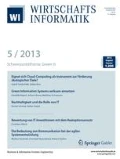Abstract
Expressiveness is applied to evaluate languages or descriptions. By expressiveness we mean what can be said within the limitations of some language. Assessing expressiveness is always based on a reference, namely the set of all things sayable, the things said in another language or the things that must be said to meet a certain purpose. So far, only nominal or ordinal measures of expressiveness have been proposed.
In the approach presented here, a certain purpose serves as reference to evaluate expressiveness by a cardinal measure. The approach is derived from measuring similarity between binary vectors and employs results concerning the formal semantics of logical descriptions. By applying this approach to measure the expressiveness of the master data used by Advanced Planning and Scheduling (APS) systems on the one hand and Enterprise Resource Planning (ERP) systems on the other hand it can be shown that in most cases the master data of APS systems do not possess higher expressiveness than the master data of ERP systems.
Similar content being viewed by others
Literatur
Baader, F.: A Formal Definition for the Expressive Power of Terminological Knowledge Representation Languages. In: Journal of Logic and Computation 6 (1996) 1, S. 33–54.
Batini, C.; Ceri, S.; Navathe, S. B.: Conceptual Database Design. 4. Aufl., Redwood City et al. 1992.
Badia, A.: Extending Entity-Relationship Models with Higher-Order Operators. In: Zbigniew, W. R.; Ohsuga, S. (Hrsg.): Foundations of Intelligent Systems. Berlin et al. 2000, S. 321–330.
Backhaus, K.; Erichson, B.; Plinke, W.; Weiber, R.: Multivariate Analysemethoden — Eine anwendungsorientierte Einführung. 9. Aufl., Berlin et al. 2000.
Boehm, B.; Basili, V. R.: Software Defect Reduction Top 10. In: Computer 34 (2001) 1, S. 135–137.
Borgida, A.: On the relative expressiveness of description logics and predicate logics. In: Artificial Intelligence 82 (1996) 2, S. 353–367.
Bunge, M.: Treatise on Basic Philosophy. Vol. III: Ontology I — The Furniture of the World. Dordrecht 1977.
Chandra, A. K.: Theory of Database Queries. In: ACM (Hrsg.): Proceedings of the 7th ACM SIGACT-SIGMOD-SIGART Symposium on Principles of Database Systems. New York 1988, S. 1–9.
Dudek, G.; Rohde, J.; Sürie, C.: Advanced Planning Systems — Lösungsverfahren und Modellierung. In: Industrie Management 18 (2002) 6, S. 49–52.
Frank, U.: Zur Verwendung formaler Sprachen in der Wirtschaftsinformatik: Notwendiges Merkmal eines wissenschaftlichen Anspruchs oder Ausdruck eines übertriebenen Szientismus. In: Becker, J. (Hrsg.): Wirtschaftsinformatik und Wissenschaftstheorie — Bestandsaufnahme und Perspektiven. Wiesbaden 1999, S. 127–160.
Frank, U.; van Laak, B. L.: Anforderungen an Sprachen zur Modellierung von Ge-schäftsprozessen. Arbeitsbericht Nr. 34 des Instituts für Wirtschaftsinformatik, Universität Koblenz-Landau 2003.
Gregersen, H.; Jensen, C. S.: On the Onto-logical Expressiveness of Temporal Extensions to the Entity-Relationship Model. In: Chen, P. P. (Hrsg.): Advances in Conceptual Modeling — Proceedings ER ’99. Berlin et al. 1999, S. 110–121.
Green, P.; Rosemann, M.: Integrated Process Modeling: An Ontological Evaluation. In: Information Systems 25 (2000) 2, S. 73–87.
Hermes, H.: Einführung in die mathematische Logik: Klassische Prädikatenlogik. 5. Aufl., Stuttgart 1991.
Heinemann, B.; Weihrauch, K.: Logik für Informatiker: Eine Einführung. 2. Aufl., Stuttgart 1992.
Jeavons, P.; Cohen, D.; Gyssens, M.: How to Determine the Expressive Power of Constraints. In: Constraints — An International Journal 4 (1999) 2, S. 113–131.
Kilger, C.: Optimierung der Supply Chain durch Advanced Planning Systems. In: IM — Information Management & Consulting 13 (1998) 3, S. 49–55.
Kreowski, H.-J.: Logische Grundlagen der Informatik. München-Wien 1991.
Kurtonina, N.; de Rijke, M.: Expressiveness of concept expressions in first-order description logics. In: Artificial Intelligence 107 (1999) 2, S. 303–333.
Kung, C. H.: An analysis of three conceptual models with time perspective. In: Olle, T. W.; Sol, H. G.; Tully, C. J. (Hrsg.): Information Systems Design Methodologies: A Feature Analysis. Amsterdam et al. 1983, S. 141–167.
Layden, J.: APS is here to stay: The history of advanced planning & scheduling from one who knows. In: Manufacturing Systems 17 (1999) 1, S. 66–68.
MSI: Advanced Planning. http://www.manufacturingsystems.com/glossary, Abruf am 2003-05-09.
Nebel, B.: Die Ausdrucksstarke von Planungsformalismen: Eine formale Charakterisierung. In: Künstliche Intelligenz 13 (1999) 3, S. 12–19.
Ortner, E.: Methodenneutraler Fachentwurf. Stuttgart — Leipzig 1997.
proALPHA Software AG: Funktionen im Überblick — Advanced Planning and Scheduling. http://www.proalpha.de, Abruf am 2003-05-09.
Reihlen, M.: Die Passivistische Abbildungsthese und die Aktivistische Konstruktions-these in der Modelldiskussion (I). In: Das Wirtschaftsstudium 27 (1998) 2, S. 157–162.
Sapia, C.; Blaschka, M.; Höfling, G.; Dinter, B.: Extending the E/R Model for the Multidimensional Paradigm. In: Kambayashi, Y.; Lee, D. L.; Lim, E.-P.; Mohania, M. K.; Masun-ga, Y. (Hrsg.): Advances in Database Technologies. Berlin et al. 1999, S. 105–116.
SAP AG: SAP Bibliothek, Release 4.6 C. http://help.sap.com, April 2001, Abruf am 2003-12-10.
SAP AG: SAP Bibliothek, APO — Advanced Planner and Optimizer, Release 3.1A. http://help.sap.com, Mai 2002, Abruf am 2003-12-09.
Schäuble, P.; Wüthrich, B.: On the Expressive Power of Query Languages. Report 173, Fachbereich Informatik, Institut für Informationssysteme, ETH Zürich 1992.
Stadtler, H.; Kilger, C.: Supply Chain Management and Advanced Planning: Concepts, Models, Software and Case Studies. 2. Aufl., Berlin et al. 2002.
ter Hofstede, A. H. M.; van der Weide, T. P.: Expressiveness in conceptual data modelling. In: Data & Knowledge Engineering 10 (1993) 1, S. 65–100.
Wight, O. W.: Manufacturing Resource Planning — MRP II: Unlocking America’s Productivity Potential. New York 1981.
Author information
Authors and Affiliations
Corresponding author
Rights and permissions
About this article
Cite this article
Patig, S. Zur Ausdrucksstärke der Stammdaten des Advanced Planning and Scheduling. Wirtschaftsinf 46, 97–106 (2004). https://doi.org/10.1007/BF03250929
Issue Date:
DOI: https://doi.org/10.1007/BF03250929




